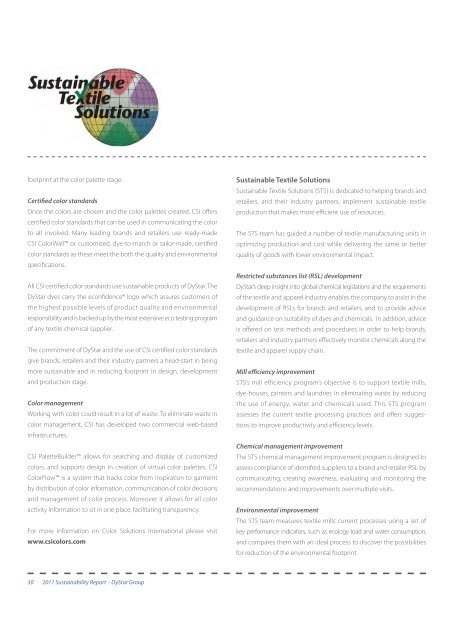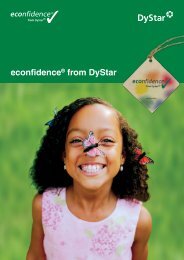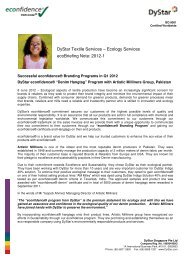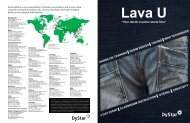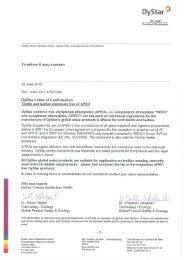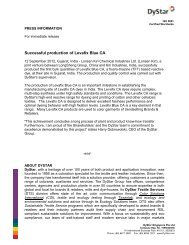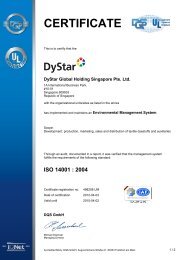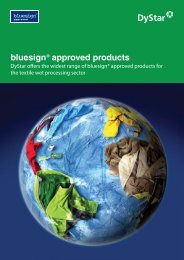Read the DyStar Sustainability Report 2011...
Read the DyStar Sustainability Report 2011...
Read the DyStar Sustainability Report 2011...
Create successful ePaper yourself
Turn your PDF publications into a flip-book with our unique Google optimized e-Paper software.
footprint at <strong>the</strong> color palette stage.<br />
Certified color standards<br />
Once <strong>the</strong> colors are chosen and <strong>the</strong> color palettes created, CSI offers<br />
certified color standards that can be used in communicating <strong>the</strong> color<br />
to all involved. Many leading brands and retailers use ready-made<br />
CSI ColorWall or customized, dye-to-match or tailor-made, certified<br />
color standards as <strong>the</strong>se meet <strong>the</strong> both <strong>the</strong> quality and environmental<br />
specifications.<br />
All CSI certified color standards use sustainable products of <strong>DyStar</strong>. The<br />
<strong>DyStar</strong> dyes carry <strong>the</strong> econfidence® logo which assures customers of<br />
<strong>the</strong> highest possible levels of product quality and environmental<br />
responsibility and is backed up by <strong>the</strong> most extensive eco testing program<br />
of any textile chemical supplier.<br />
The commitment of <strong>DyStar</strong> and <strong>the</strong> use of CSI certified color standards<br />
give brands, retailers and <strong>the</strong>ir industry partners a head-start in being<br />
more sustainable and in reducing footprint in design, development<br />
and production stage.<br />
Color management<br />
Working with color could result in a lot of waste. To eliminate waste in<br />
color management, CSI has developed two commercial web-based<br />
infrastructures.<br />
CSI PaletteBuilder allows for searching and display of customized<br />
colors, and supports design in creation of virtual color palettes. CSI<br />
ColorFlow is a system that tracks color from inspiration to garment<br />
by distribution of color information, communication of color decisions<br />
and management of color process. Moreover it allows for all color<br />
activity information to sit in one place, facilitating transparency.<br />
For more information on Color Solutions International please visit<br />
www.csicolors.com<br />
30 2011 <strong>Sustainability</strong> <strong>Report</strong> - <strong>DyStar</strong> Group<br />
Sustainable Textile Solutions<br />
Sustainable Textile Solutions (STS) is dedicated to helping brands and<br />
retailers, and <strong>the</strong>ir industry partners, implement sustainable textile<br />
production that makes more efficient use of resources.<br />
The STS team has guided a number of textile manufacturing units in<br />
optimizing production and cost while delivering <strong>the</strong> same or better<br />
quality of goods with lower environmental impact.<br />
Restricted substances list (RSL) development<br />
<strong>DyStar</strong>’s deep insight into global chemical legislations and <strong>the</strong> requirements<br />
of <strong>the</strong> textile and apparel industry enables <strong>the</strong> company to assist in <strong>the</strong><br />
development of RSLs for brands and retailers, and to provide advice<br />
and guidance on suitability of dyes and chemicals. In addition, advice<br />
is offered on test methods and procedures in order to help brands,<br />
retailers and industry partners effectively monitor chemicals along <strong>the</strong><br />
textile and apparel supply chain.<br />
Mill efficiency improvement<br />
STS’s mill efficiency program’s objective is to support textile mills,<br />
dye-houses, printers and laundries in eliminating waste by reducing<br />
<strong>the</strong> use of energy, water and chemicals used. This STS program<br />
assesses <strong>the</strong> current textile processing practices and offers suggestions<br />
to improve productivity and efficiency levels.<br />
Chemical management improvement<br />
The STS chemical management improvement program is designed to<br />
assess compliance of identified suppliers to a brand and retailer RSL by<br />
communicating, creating awareness, evaluating and monitoring <strong>the</strong><br />
recommendations and improvements over multiple visits.<br />
Environmental improvement<br />
The STS team measures textile mills’ current processes using a set of<br />
key performance indicators, such as ecology load and water consumption,<br />
and compares <strong>the</strong>m with an ideal process to discover <strong>the</strong> possibilities<br />
for reduction of <strong>the</strong> environmental footprint.


